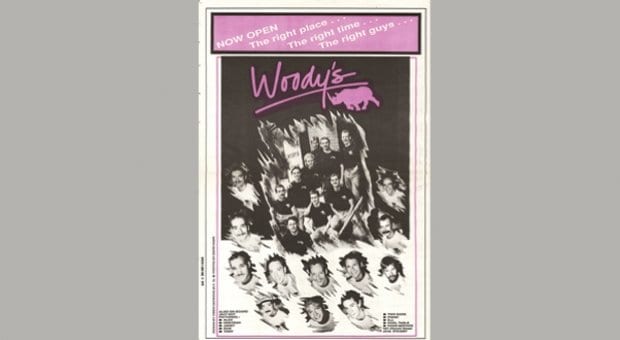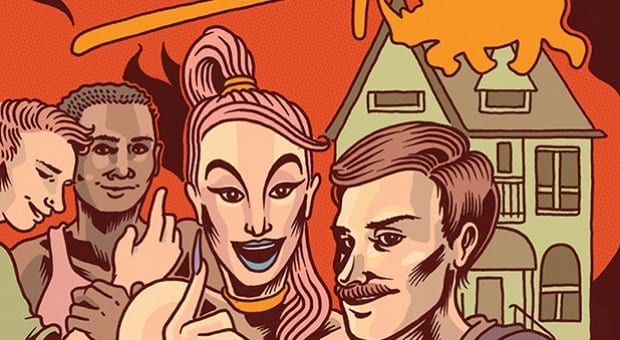
An ad announcing the opening of Woody’s that ran in Xtra #129, released June 29, 1989. Credit: ????
While perusing early issues of Xtra, I found a 25-year-old advertisement for the opening of one of Toronto’s oldest gay bars: Woody’s. It’s a full-page ad, with the words “NOW OPEN. The right place … The right time … The right guys” across the top, and the rest is a sort of collage of men’s faces. As I gazed at those faces, most drooping beneath the weight of ugly mustaches, it occurred to me that most queer men in Toronto have experienced Woody’s to some degree. Whether or not it became a regular haunt for all of us, it’s hard to imagine the Village without it.
To learn more about the history of Woody’s, I interviewed two people who’ve worked there since the beginning — its general managers, Steven Clegg and Dean Odorico. When owner Alex Korn opened Woody’s in July 1989, he didn’t want it to be simply a bar, but an establishment that helped the community. Consequently, the bar opened with a benefit for the AIDS Committee of Toronto. “The AIDS crisis was huge. We lost a lot of friends, a lot of staff,” Odorico says. Over the years, Woody’s has maintained this mandate, raising well over $100,000 for the AIDS Committee of Toronto. They’ve also given their support to organizations like Casey House and Buddies in Bad Times Theatre and have sponsored a variety of queer sports teams.
When Woody’s opened, there were plenty of queer clubs in the city, along with a few bars, but there were very few on Church Street itself. The area was home to the CBC offices and steakhouses that catered to rowdy, mostly heterosexual hockey fans en route to games at Maple Leaf Gardens. Because Woody’s wasn’t a dance club, but just a bar, many people thought it wouldn’t last very long. Not only did Woody’s last, but when the CBC and later the hockey and hockey-related business moved away, the success of Woody’s most likely served as encouragement for other businesses to move to the area.
Woody’s popularity grew with what Odorico describes as the “Pride explosion.” By the mid-1990s, Pride-related tourism was huge and the crowds were dangerously large. Odorico recalls one occasion: “There were women with babies out in front of the bar. The parade was over, and everyone was starting to move up Church Street. The women couldn’t move anywhere, so they had to pass their babies to our security and we took them in and let them out the back door.”
Queer as Folk gained Woody’s international attention. The show was set in Pittsburgh but shot in Toronto, and Woody’s was one of its bars. Woody’s was also used as another bar for the show, called Moosie’s, for which they had to alter the exterior. “A lot of people would come and get their picture taken on the front steps. There was also bus tours, where you’d get taken to all the places on the show,” Odorico says. Woody’s was such a hit that during the late 1990s its beer sales were among the top five in the entire province.
In addition to helping shape Church Street and its ongoing contributions to charity and local organizations, Woody’s was very important in the early 1990s as a place to find other guys. Before online dating sites and smartphone apps, people mostly had to go to bars and clubs to hook up. With changing social media and increasing social acceptance, many people have moved away from the Village and queer-specific venues, but Woody’s remains popular. Odorico is happy with many of the changes that have occurred: “At one time, gay bars were the centre of the universe for gay people, and they’re still important, but it’s okay to be gay now, and I’m glad to be whatever small part of [the community] we are. I love when I see two guys walking down the street holding hands. That wouldn’t have happened 20 years ago. It’s beautiful to see the acceptance.”
Woody’s will celebrate its 25th anniversary this summer, and while the date and party details are not yet firmed up, Odorico says it will involve some kind of “look back” at the long history of this queer landmark.
(History Boys appears on Daily Xtra on the first and third Tuesday of every month. You can
also follow them on Facebook.)


 Why you can trust Xtra
Why you can trust Xtra


